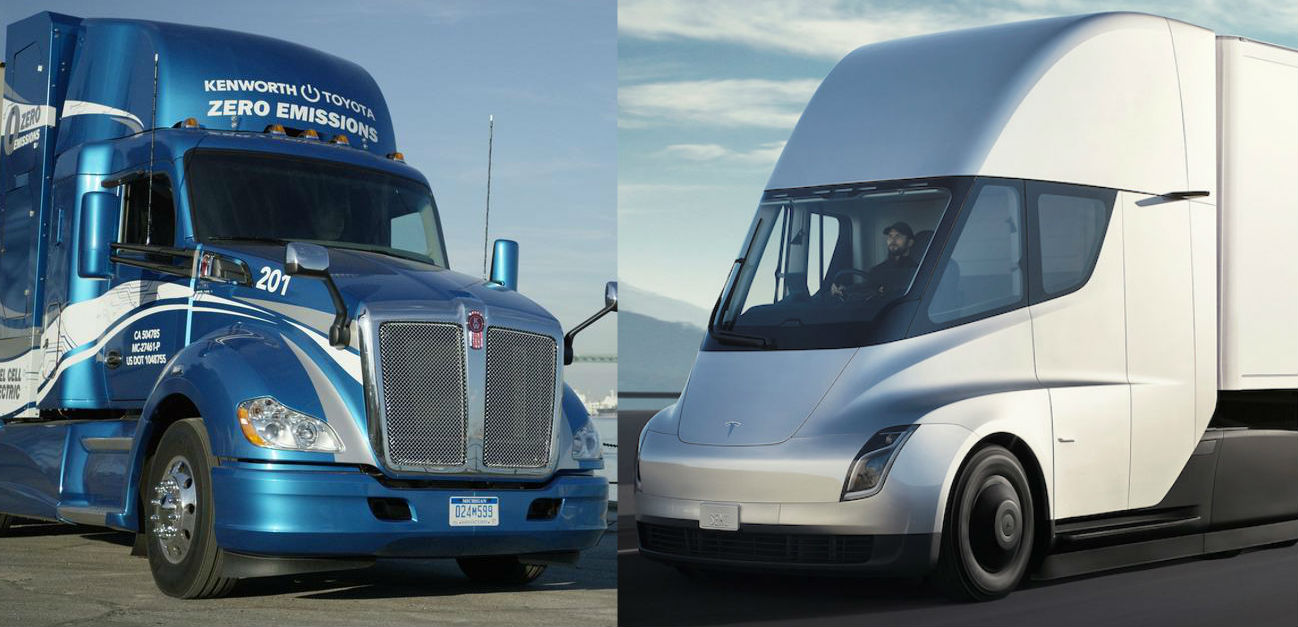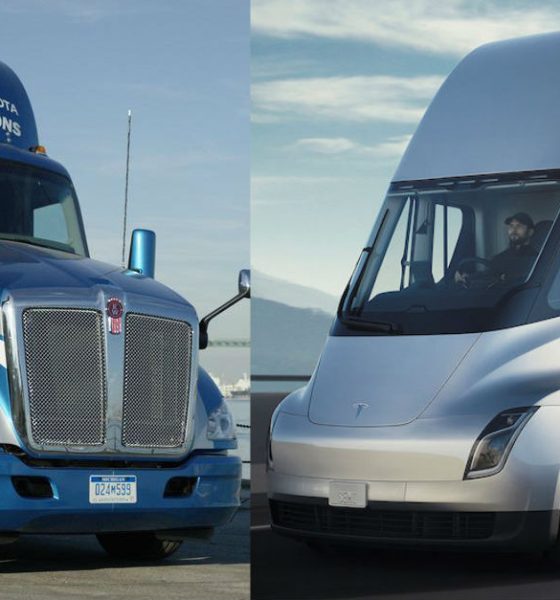

News
Tesla Semi gets ‘peppy and quiet’ hydrogen fuel cell competitor from Kenworth-Toyota
With support from the California Air Resources Board, Japanese auto giant Toyota and truck maker are collaborating to develop and build a limited run of hydrogen fuel trucks. The vehicles, which are Kenworth T680 trucks modified with Toyota’s hydrogen fuel cell powertrains, are expected to drive on routes around Los Angeles and further inland to San Bernardino. The actual specs of the vehicles have not been announced by either company, but the range of the hydrogen fuel cell T680 trucks are said to be 300 miles in “normal drayage operating conditions.”
Toyota and Paccar, the parent company behind Kenworth, took the wraps off the first hydrogen fuel cell long-hauler at this month’s Consumer Electronics Show in Las Vegas. The vehicle, which is classified as a Class 8 truck, stands to be a possible competitor for upcoming all-electric trucks like the Tesla Semi in the future. In a statement to CNBC, Brian Lindgren, Kenworth’s director of research and development, noted that utilizing hydrogen as a source of propulsion makes more sense for Class 8 vehicles than batteries, which power vehicles like Tesla’s all-electric long-hauler.
“We believe that carrying energy in the form of hydrogen for heavy-duty Class 8 trucks makes more sense than carrying it in batteries because the trucks can be refilled faster and offer longer range,” he said.
Lindgren’s point about faster refilling times for hydrogen fuel cell vehicles is quite justified, considering that a passenger car such as a Toyota Mirai could refill its tank with around 300 miles of range in roughly five minutes. That’s significantly faster than Tesla’s Superchargers, which are capable of charging roughly 200 miles of range in 30 minutes. Larger vehicles such as the hydrogen-electric Kenworth T680 trucks would likely take longer to refill than a passenger car such as the Mirai, but there’s a good chance that the long-hauler could still refill its tank faster than the Tesla Semi could charge its batteries, even if it is plugged into the upcoming Megacharger Network.
Toyota-Paccar’s Kenworth T680 hybrid fuel cell trucks caught the attention of some CES attendees due to the vehicle’s silent operation, which is nearly comparable to an all-electric truck. Lindgren, for his part, noted that drivers who have operated the truck actually appreciated the silence of the vehicle. “Drivers like these trucks because they are peppy and quiet,” he said.
Andy Lund, the Toyota chief engineer on the project, further stated that the hydrogen-electric trucks would have the same payload capacity as a diesel rig. Unlike its fossil fuel-powered counterparts, the hydrogen fuel cell Kenworth T680 long-haulers would only require a four-speed transmission, which is far simpler than the 18-gear transmissions usually fitted on Class 8 diesel trucks.
If there is one thing that would probably go against Toyota and Paccar’s hydrogen trucks, though, it would be their fuel efficiency. Kenworth’s director of research and development noted that the prototype trucks currently consume hydrogen at roughly the same rate as present diesel trucks, at around 5-7 mpg. The only advantage of the vehicles, of course, is that the trucks would only produce water vapor from their exhausts. This is a substantial advantage, considering that the trucking industry accounts for about 23% of carbon emissions from transportation in 2016, according to the Environmental Protection Agency.
That said, this would be something that Tesla could capitalize on. During the electric long-hauler’s unveiling, Musk noted that the Semi would cost operators $1.26 per mile to run, less than the standard $1.51 per mile that diesel-powered vehicles cost. Musk’s estimate has been met by skepticism by veterans of the trucking industry, but if the Tesla Semi’s operating costs stay true to the CEO’s estimate, then the vehicle would most certainly give itself a notable advantage over diesel and hydrogen-powered rivals when it starts operating on America’s roads.
Hydrogen fuel cells remain a polarizing solution for sustainable transportation. Elon Musk, for one, has openly discussed his dislike for hydrogen-electric transportation. In a statement to Autocar in 2014, for one, Musk went so far as to describe hydrogen fuel cell systems as “mind-bogglingly stupid.”
“They’re mind-bogglingly stupid. You can’t even have a sensible debate. Consider the whole fuel cell system against a Model S. It’s far worse in volume and mass terms, and far, far, worse in cost. And I haven’t even talked about hydrogen being so hard to handle. Success is simply not possible. Manufacturers do it [FCEVs] because they’re under pressure to show they’re doing something ‘constructive’ about sustainability. They feel it’s better to be working on a solution a generation away rather than something just around the corner. Hydrogen is always labeled the fuel of the future – and always will be,” Musk said.
Elon Musk initially announced that the Tesla Semi would start production sometime in 2019. That said, later statements from Tesla’s head of investor relations Martin Viecha suggested that the electric car maker would “earnestly” start producing the Semi by 2020.

News
Tesla FSD fleet is nearing 7 billion total miles, including 2.5 billion city miles
As can be seen on Tesla’s official FSD webpage, vehicles equipped with the system have now navigated over 6.99 billion miles.

Tesla’s Full Self-Driving (Supervised) fleet is closing in on almost 7 billion total miles driven, as per data posted by the company on its official FSD webpage.
These figures hint at the massive scale of data fueling Tesla’s rapid FSD improvements, which have been quite notable as of late.
FSD mileage milestones
As can be seen on Tesla’s official FSD webpage, vehicles equipped with the system have now navigated over 6.99 billion miles. Tesla owner and avid FSD tester Whole Mars Catalog also shared a screenshot indicating that from the nearly 7 billion miles traveled by the FSD fleet, more than 2.5 billion miles were driven inside cities.
City miles are particularly valuable for complex urban scenarios like unprotected turns, pedestrian interactions, and traffic lights. This is also the difference-maker for FSD, as only complex solutions, such as Waymo’s self-driving taxis, operate similarly on inner-city streets. And even then, incidents such as the San Francisco blackouts have proven challenging for sensor-rich vehicles like Waymos.
Tesla’s data edge
Tesla has a number of advantages in the autonomous vehicle sector, one of which is the size of its fleet and the number of vehicles training FSD on real-world roads. Tesla’s nearly 7 billion FSD miles then allow the company to roll out updates that make its vehicles behave like they are being driven by experienced drivers, even if they are operating on their own.
So notable are Tesla’s improvements to FSD that NVIDIA Director of Robotics Jim Fan, after experiencing FSD v14, noted that the system is the first AI that passes what he described as a “Physical Turing Test.”
“Despite knowing exactly how robot learning works, I still find it magical watching the steering wheel turn by itself. First it feels surreal, next it becomes routine. Then, like the smartphone, taking it away actively hurts. This is how humanity gets rewired and glued to god-like technologies,” Fan wrote in a post on X.
News
Tesla starts showing how FSD will change lives in Europe
Local officials tested the system on narrow country roads and were impressed by FSD’s smooth, human-like driving, with some calling the service a game-changer for everyday life in areas that are far from urban centers.

Tesla has launched Europe’s first public shuttle service using Full Self-Driving (Supervised) in the rural Eifelkreis Bitburg-Prüm region of Germany, demonstrating how the technology can restore independence and mobility for people who struggle with limited transport options.
Local officials tested the system on narrow country roads and were impressed by FSD’s smooth, human-like driving, with some calling the service a game-changer for everyday life in areas that are far from urban centers.
Officials see real impact on rural residents
Arzfeld Mayor Johannes Kuhl and District Administrator Andreas Kruppert personally tested the Tesla shuttle service. This allowed them to see just how well FSD navigated winding lanes and rural roads confidently. Kruppert said, “Autonomous driving sounds like science fiction to many, but we simply see here that it works totally well in rural regions too.” Kuhl, for his part, also noted that FSD “feels like a very experienced driver.”
The pilot complements the area’s “Citizen Bus” program, which provides on-demand rides for elderly residents who can no longer drive themselves. Tesla Europe shared a video of a demonstration of the service, highlighting how FSD gives people their freedom back, even in places where public transport is not as prevalent.
What the Ministry for Economic Affairs and Transport says
Rhineland-Palatinate’s Minister Daniela Schmitt supported the project, praising the collaboration that made this “first of its kind in Europe” possible. As per the ministry, the rural rollout for the service shows FSD’s potential beyond major cities, and it delivers tangible benefits like grocery runs, doctor visits, and social connections for isolated residents.
“Reliable and flexible mobility is especially vital in rural areas. With the launch of a shuttle service using self-driving vehicles (FSD supervised) by Tesla in the Eifelkreis Bitburg-Prüm, an innovative pilot project is now getting underway that complements local community bus services. It is the first project of its kind in Europe.
“The result is a real gain for rural mobility: greater accessibility, more flexibility and tangible benefits for everyday life. A strong signal for innovation, cooperation and future-oriented mobility beyond urban centers,” the ministry wrote in a LinkedIn post.
News
Tesla China quietly posts Robotaxi-related job listing
Tesla China is currently seeking a Low Voltage Electrical Engineer to work on circuit board design for the company’s autonomous vehicles.

Tesla has posted a new job listing in Shanghai explicitly tied to its Robotaxi program, fueling speculation that the company is preparing to launch its dedicated autonomous ride-hailing service in China.
As noted in the listing, Tesla China is currently seeking a Low Voltage Electrical Engineer to work on circuit board design for the company’s autonomous vehicles.
Robotaxi-specific role
The listing, which was shared on social media platform X by industry watcher @tslaming, suggested that Tesla China is looking to fill the role urgently. The job listing itself specifically mentions that the person hired for the role will be working on the Low Voltage Hardware team, which would design the circuit boards that would serve as the nervous system of the Robotaxi.
Key tasks for the role, as indicated in the job listing, include collaboration with PCB layout, firmware, mechanical, program management, and validation teams, among other responsibilities. The role is based in Shanghai.
China Robotaxi launch
China represents a massive potential market for robotaxis, with its dense urban centers and supportive policies in select cities. Tesla has limited permission to roll out FSD in the country, though despite this, its vehicles have been hailed as among the best in the market when it comes to autonomous features. So far, at least, it appears that China supports Tesla’s FSD and Robotaxi rollout.
This was hinted at in November, when Tesla brought the Cybercab to the 8th China International Import Expo (CIIE) in Shanghai, marking the first time that the autonomous two-seater was brought to the Asia-Pacific region. The vehicle, despite not having a release date in China, received a significant amount of interest among the event’s attendees.








